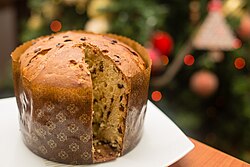Panettone


Panettone (lombardisch: panadùn) ist eine traditionelle Mailänder feine Backware, die vorwiegend in der Weihnachtszeit verzehrt wird. Die Produktspezifikation und die Herstellung sind durch eine offizielle Beschreibung festgelegt (Disciplinare di produzione del „Panettone tipico della tradizione artigiana Milanese“).[1] „Panettone“ ist eine eingetragene Marke der Handelskammer Mailand.
Zutaten
Für die Herstellung des traditionellen Panettones sind ausschließlich folgende Zutaten erlaubt: Wasser, Mehl, Zucker, Frischei, pasteurisierte Eiprodukte, Milch, Kondensmilch, Joghurt, Kakaobutter, Butter, Sultaninen, Orangeat und Zitronat (Mindestmaß der Stücke 8 × 8 mm), Salz. Weitere mögliche Zutaten sind Honig, Malz und Malzextrakt, Vanille, natürliche Aromen oder naturidentische Aromen. Andere Zutaten sind ausdrücklich ausgeschlossen: Konservierungsstoffe, Sojalecithin oder Farbstoffe.[1]
Herstellung
Panettone wird traditionell aus Weizensauerteig mit langer Gärzeit hergestellt, wodurch er sein typisches Aroma erhält. Der Teig ist weich, aber noch knetbar, enthält kandierte Früchte und Rosinen, und wird traditionell in speziellen Papiermanschetten gebacken, wodurch der Kuchen eine Kuppelgestalt von etwa 20 Zentimeter Höhe bekommt. Er wird in Sektoren serviert, dazu gibt es heiße, süße Getränke oder süßen Wein wie zum Beispiel Spumante oder Moscato.
Die bekanntesten Hersteller von industriell gefertigtem Panettone sind Motta, Bauli, Paluani, Alemagna und Le Tre Marie. Daneben gibt es in ganz Norditalien viele Bäckereien, die in der Vorweihnachtszeit den Panettone auf traditionelle Weise herstellen.
Panettone ist überdurchschnittlich lange haltbar. Das Mindesthaltbarkeitsdatum wird oft mit sechs Wochen angegeben.
Geschichte
Obgleich süßes Brot zu Weihnachten bereits seit Jahrhunderten gebacken wurde, so war es erst der Mailänder Bäcker Angelo Motta, der im Jahre 1919 auf die Idee kam, dem damals in seiner Heimatstadt weitverbreiteten, flachen und sehr kompakten Fladen namens Panettone („großes Brot“) mit Sauerteighefen zu mehr Volumen zu verhelfen und es mit kandierten Früchten anzureichern.
Wenngleich der industrielle Panettone in seiner heutigen Form bereits in der Zwischenkriegszeit entstand, so gelang ihm der tatsächliche Durchbruch erst nach dem Zweiten Weltkrieg. Erst im Laufe der 1990er-Jahre haben etliche kleinere Pasticcerie überhaupt damit begonnen, Panettoni auf handwerkliche Art zu backen.[2][3]
In anderen Ländern
Unter dem Namen Panetón findet man diese Backware auch in Peru als typischen Weihnachtskuchen. Zur Weihnachtszeit werden dort ca. 20 Millionen Stück verkauft.[4] Auch in weiteren Ländern der Region wie Bolivien ist Panetón beliebt und ab Ende Oktober in großen Mengen erhältlich. Allerdings folgen nur wenige Anbieter dem Originalrezept.
Siehe auch
Weblinks
- Produktspezifikation und Produktionsvorschriften der Camera di commercio Milano Monza Brianza Lodi (italienisch)
- Panettone in der Datenbank von Kulinarisches Erbe der Schweiz (italienisch)
Einzelnachweise
- ↑ a b Comitato Tecnico dei Maestri Pasticceri Milanesi: Panettone tipico della tradizione artigiana Milanese. (PDF) Camera di Commercio Industria Artigianato e Agricoltura di Milano, September 2003, abgerufen am 25. Dezember 2019 (italienisch, Offizielle Denomination.).
- ↑ Georges Desrues: Wo der Panettone herkommt und was ihn ausmacht , in: Der Standard, 18. Dezember 2021
- ↑ Italienische Küche: Historiker entlarvt Mythen und erntet viel Wut. 24. Mai 2024, abgerufen am 24. Mai 2024.
- ↑ Martin Morales: Ceviche – Peruanische Küche. Fackelträger Verlag, Köln 2014, ISBN 978-3-7716-4551-9, S. 106.
Auf dieser Seite verwendete Medien
Autor/Urheber: Hp.Baumeler, Lizenz: CC BY-SA 4.0
Geschenkverpackung Panettone (Münger 2018)
Autor/Urheber: N i c o l a from Fiumicino (Rome), Italy, Lizenz: CC BY 2.0
Panettone (pronounced /ˌpænᵻˈtoʊni/;[1][2][3] Italian: [panetˈtoːne]) is a type of sweet bread loaf originally from Milan (in Milanese dialect of the Lombard language it is called paneton /paneˈtuŋ/),[4] usually prepared and enjoyed for Christmas and New Year in Italy, southeastern France, Spain, Portugal, Slovenia, Brazil, Venezuela, Peru, Malta, Montenegro, Albania, Eritrea, Georgia, Germany, Austria and Switzerland and Canada , and is one of the symbols of the city of Milan. In recent years it has become a popular addition to the Christmas table in Canada, Puerto Rico, Mexico, and Australia. In South America, especially in Brazil, Peru, Argentina, Paraguay, Uruguay, Colombia, Bolivia, and Chile. Each country names the special bread differently. In some countries it is a tradition to eat it on 7 January each year.[citation needed] It has a cupola shape, which extends from a cylindrical base and is usually about 12–15 cm high for a panettone weighing 1 kg. Other bases may be used, such as an octagon, or a frustum with a star section shape more common to pandoro. It is made during a long process that involves curing the dough, which is acidic, similar to sourdough. The proofing process alone takes several days, giving the cake its distinctive fluffy characteristics. It contains candied orange, citron, and lemon zest, as well as raisins, which are added dry and not soaked. Many other variations are available such as plain or with chocolate. It is served in slices, vertically cut, accompanied with sweet hot beverages or a sweet wine, such as Asti or Moscato d'Asti. In some regions of Italy, it is served with crema di mascarpone, a cream made from mascarpone, eggs, sometimes dried or candied fruits, and typically a sweet liqueur such as amaretto; if mascarpone cheese is unavailable, zabaione is sometimes used as a substitute.
Efforts are under way to obtain Protected Designation of Origin and Denominazione di origine controllata status for this product, but, as of late 2008, this had not occurred.[5] Italian Agriculture Minister Paolo De Castro was looking at ways to protect genuine Italian cakes from growing competition in Latin America and whether action could be taken at the World Trade Organization.
